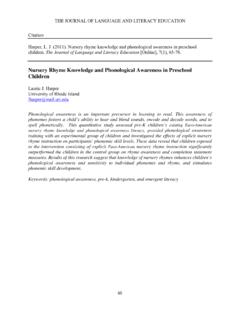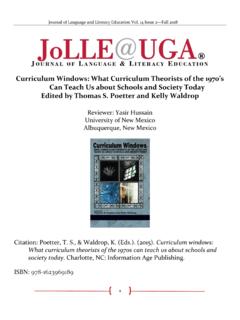Transcription of What is Literacy - Jolle@UGA
1 Volume 8 Number 1 Spring 2012 Editor Lindy L. Johnson what is Literacy ? A Critical overview of Sociocultural Perspectives Kristen H. Perry University of Kentucky Abstract Sociocultural perspectives on Literacy include various theories focused on the myriad ways in which people use Literacy in context, which include a strong emphasis on power relations. Yet, these theories also have important differences, and many in the field of Literacy do not clearly differentiate among them. I provide a critical overview of influential sociocultural perspectives on Literacy , focusing on three major perspectives: (1) Literacy as social practice, (2) multiliteracies, and (3) critical Literacy . In an effort to support researchers in framing their scholarly work and to support practitioners and other consumers of research make sense of research, I discuss the ways in which each theory would answer the question, what is Literacy ?
2 As well as the affordances and limitations of these theories in terms of Literacy development, Literacy use, and Literacy instruction. Please cite this article as: Perry, K. (2012). what is Literacy ? A critical overview of sociocultural perspectives. Journal of Language and Literacy Education [Online], 8(1), 50-71. Available at K. Perry / what is Literacy ? A Critical overview (2012) 51 Introduction Recent Literacy policies and programs have been shaped in large part by cognitive and psycholinguistic perspectives ( , Muth & Perry, 2010; Pearson & Hiebert, 2010), such as those promoted by the National Institute for Literacy ( , McShane, 2005), the National Reading Panel (2000), and the National Early Literacy Panel (2008), that focus on particular skills such as phonemic awareness, fluency, and comprehension. Although they have had a lesser impact on policy and instruction, sociocultural approaches to Literacy have long played an important role in the field of Literacy .
3 Indeed, many of the theories that Literacy scholars draw upon in their work emerge from sociocultural perspectives (Gee, 2000; Lewis, Enciso, & Moje, 2007a; Tracey & Morrow, 2006) grounded in the work of Vygotsky (1978). While sociocultural theories of Literacy development and practice have been taken up in K-12 contexts, much of the groundwork for these theories originated in adult, family, and community Literacy research from scholars such as Street (1984), Barton and Hamilton (1998), Heath (1983), and Purcell-Gates (1995). This research has been concerned with understanding the ways in which people use Literacy in their everyday lives, finding ways to make Literacy instruction meaningful and relevant by recognizing and incorporating students out-of-school ways of practicing Literacy , and decreasing achievement gaps for students whose families and communities practice Literacy in ways that may differ from those in the mainstream or in positions of power.
4 Although there is no single sociocultural theory on Literacy , Literacy scholars sometimes treat sociocultural perspectives on Literacy as unified or interchangeable. Indeed, Lewis, Enciso, and Moje (2007b) argue that the word sociocultural has taken on both great prominence, and, we would assert, some lack of clarity in application (p. 1). One widely-adopted graduate text, Tracey and Morrow s (2006) Lenses on Reading, illustrates the way in which sociocultural theories are often undifferentiated, in comparison to cognitive theories. This book contains one chapter on social learning theories; in contrast, the cognitive theory of Constructivism receives its own chapter, and Information/Cognitive Processing theories are spread over three entire chapters. Some may argue that this treatment reflects the relative newness of the acceptance of sociocultural perspectives on Literacy development; however, sociocultural and sociolinguistic theories on Literacy development and practice have been influential for decades.
5 Because of the differences among the various theories united under the sociocultural umbrella, it is more appropriate to speak of sociocultural perspectives as a collection of related theories that include significant emphases on the social and cultural contexts in which Literacy is practiced. Major theoretical perspectives within this paradigm include Literacy as a social practice, multiliteracies, and multiple literacies. Sociocultural perspectives also include an emphasis on power relations; thus, critical theories play an important role in this perspective. In fact, Lewis, Enciso, and Moje (2007a) suggest that the term critical sociocultural perspective may be appropriate to describe many of these theories. Having a clear understanding of the specific theories that fall under the sociocultural umbrella is important for both Literacy researchers and Literacy practitioners. For example, is there a difference between multiliteracies and multiple literacies?
6 Are new literacies and new Literacy studies the same? The theoretical ways in which we describe Literacy matter: Terms like new literacies, multiliteracies, or Literacy as a social practice have implications that extend beyond the pages of scholarly and professional journals: K. Perry / what is Literacy ? A Critical overview (2012) 52 Metaphors for Literacy do not stand on their own. They are part of a particular view on Literacy that has implications for how we think about learners, how we think about what they ought to learn and how this could be achieved. (Papen, 2000, p. 12) Given the ways in which theories shape our understandings of Literacy learning and instruction, my goal in this manuscript is to provide a critical overview of influential sociocultural perspectives on Literacy . As there simply is not enough space for a complete review of all theories that fall under the sociocultural umbrella, I focus this review on three major perspectives: (1) Literacy as social practice, (2) multiliteracies, and (3) critical Literacy .
7 I discuss the affordances and limitations of these theories; that is, the ways in which these theories are and are not useful in speaking to Literacy development, Literacy use, and Literacy instruction. This critical overview may be helpful for Literacy researchers in framing their scholarly work; it also may help practitioners and other consumers make sense of research emerging from this paradigm. Framing the Perspective Sociocultural perspectives on Literacy are related to sociolinguistic conceptualizations of the ways in which language instantiates culture ( , Gee, 1996; Halliday, 1973), the ways in which language use varies according to contexts (Bakhtin, 1986), the relationship between language use and power (Bourdieu, 1991), and the ethnography of communication (Hymes, 1994). Halliday, coming from a functional linguistics perspective, suggested that culture is realized through language.
8 Language, thus, is never independent of social world, as it always occurs within and is shaped by a cultural context. According to Gee (1996), language always comes fully attached to other stuff : to social relations, cultural models, power and politics, perspectives on experience, values and attitudes, as well as things and places in the world (p. vii). Literacy , as one form of language use, therefore reflects all of this other stuff. Sociolinguists have described the many ways in which language and Literacy are patterned according to context what Bakhtin (1986) referred to as speech genres. Gee s (1996) construct of Discourses as an identity kit similarly illustrates the ways in which language is connected with social roles and cultural and political contexts. Bourdieu (1991) suggested that language, as a set of practices, is more than a system of words and grammatical rules, but also an often forgotten or hidden struggle over the symbolic power of a particular way of communicating (Duranti, 1997, p.)
9 45). An emphasis on culture, activity, identity, power, and the sociocultural contexts in which Literacy occurs engenders approaches that align with this epistemological viewpoint. In advocating for an ethnography of communication, Hymes (1994) argued that facets of the cultural values and beliefs, social institutions and forms, roles and personalities, history and ecology of a community may have to be examined in their bearing on communicative events and patterns (p. 12). Responding to calls for situated understandings of language and Literacy in use, much of the empirical work that has led to the development of current sociocultural perspectives has emerged from ethnographic research, discourse analysis (Rex et al., 2010), and other situated case studies of Literacy in practice. According to Street (2001), various perspectives coming out of anthropology and sociolinguistics focused researchers on the ways in which people used reading and writing in different contexts.
10 As Street notes, K. Perry / what is Literacy ? A Critical overview (2012) 53 The rich cultural variation in these practices and conceptions leads us to rethink what we mean by them and to be wary of assuming a single Literacy where we may simply be imposing assumptions derived from our own cultural practice onto other people s literacies. (p. 430) Much sociocultural research in Literacy , therefore, is built on an assumption that an understanding of Literacy requires detailed, in-depth accounts of actual practice in different cultural settings (Street, 2001, p. 430). Street warns, however, that it is not enough to extol simply the richness and variety of Literacy practices made accessible through such ethnographic detail: we also need bold theoretical models that recognize the central role of power relations in Literacy practices (p. 430). Major Sociocultural Theories of Literacy In the following sections, I describe the theories of Literacy as social practice, multiliteracies, and critical Literacy , describing what is common among the three perspectives, as well as what differs among them.

